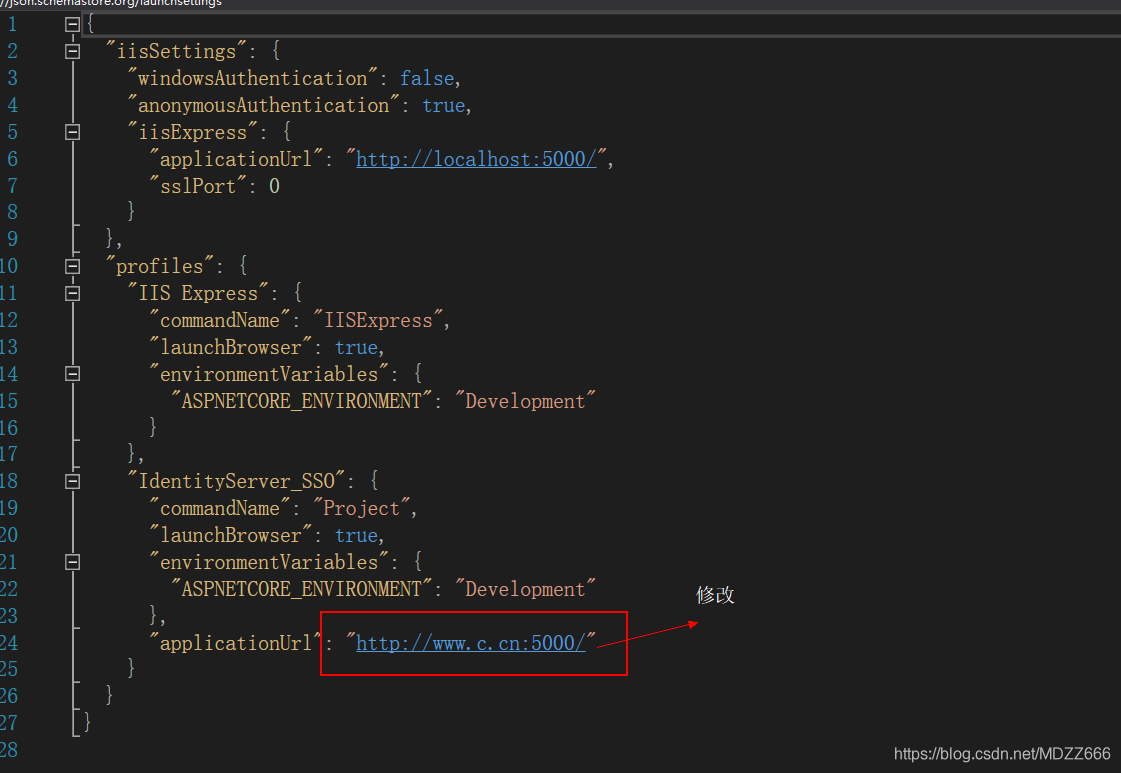一.简介
本文使用 ASP.NET Core +IdentityServer4来实现SSO单点登录(注销没有实现),我们其中使用Implicit模式和OIDC协议来实现功能,这里先记录实现核心代码,然后再来记录IdentityServer帮我们做了什么(从请求的流程来诉说)。
二.预备工作
建立 ASP.NET Core 三个项目,分别是Client_IdentityServer和Client2_IdentityServer和IdentityServer_SSO
然后修改Window的host文件,注册三个站点,分别是a.cn b.net c.cn

然后设置三个项目的启动地址,让三个项目地址分别对应上面的三个站点,我这里设置两个客户端分别是 www.a.cn 和 www.b.net ,服务端为 www.c.cn
举例

 依次按照这种方式来修改剩下的两个项目启动地址就可以了。
依次按照这种方式来修改剩下的两个项目启动地址就可以了。
服务端配置
然后在服务端点开NuGet管理包搜索IdentityServer4进行下载

新建一个Config类 ,用来配置IdentityServer4.
public class config
{
public static IEnumerable<ApiResource> GetApiResource()
{
return new List<ApiResource>()
{
new ApiResource("api","this is api")
};
}
public static IEnumerable<IdentityResource> GetIdentityResources()
{
return new List<IdentityResource>()
{
new IdentityResources.OpenId(),
new IdentityResources.Profile(),
new IdentityResources.Phone()
};
}
public static List<TestUser> GetTestUsers()
{
return new List<TestUser>{
new TestUser()
{
SubjectId="123",
Username="Mr.wen",
Password="123465",
Claims=new Claim[]
{
new Claim(ClaimTypes.Role,"管理员")
}
},
new TestUser()
{
SubjectId="456",
Username="123",
Password="123456",
Claims=new Claim[]
{
new Claim(ClaimTypes.Role,"阅览者")
}
}
};
}
public static IEnumerable<Client> GetClients()
{
return new List<Client>()
{
new Client()
{
ClientId="mvc_imp",
ClientName="Mvc_Name",
AllowedGrantTypes=GrantTypes.Implicit,
设置是否要授权
//RequireConsent=false,
//指定允许令牌或授权码返回的地址(URL)
RedirectUris={ "http://www.b.net:5001/signin-oidc","http://www.a.cn:5002/signin-oidc" },
//指定允许注销后返回的地址(URL),这里写两个客户端
PostLogoutRedirectUris={ "http://www.b.net:5001/signout-callback-oidc","http://www.a.cn:5002/signout-callback-oidc" },
ClientSecrets={new Secret("secret".Sha256())},
AllowedScopes = new List<string>
{
IdentityServerConstants.StandardScopes.OpenId,
IdentityServerConstants.StandardScopes.Profile,
},
}
};
}
接下来配置服务端的Startup.cs的Configure和ConfigureServices方法
public void ConfigureServices(IServiceCollection services)
{
services.AddIdentityServer(option=>
{
//可以通过此设置来指定登录路径,默认的登陆路径是/account/login
option.UserInteraction.LoginUrl = "/account/login";
})
.AddDeveloperSigningCredential()
.AddInMemoryApiResources(Config.GetApiResource())
.AddInMemoryClients(Config.GetClients())
.AddInMemoryIdentityResources(Config.GetIdentityResources())
.AddTestUsers(Config.GetTestUsers());
services.AddMvc();
}
public void Configure(IApplicationBuilder app, IHostingEnvironment env)
{
if (env.IsDevelopment())
{
app.UseBrowserLink();
app.UseDeveloperExceptionPage();
}
else
{
app.UseExceptionHandler("/Home/Error");
}
app.UseIdentityServer();
app.UseStaticFiles();
app.UseMvc(routes =>
{
routes.MapRoute(
name: "default",
template: "{controller=Home}/{action=Index}/{id?}"
);
});
}
客户端配置
配置Startup.cs文件
public void ConfigureServices(IServiceCollection services)
{
//DefaultChallengeScheme的名字要和下面AddOpenIdConnect方法第一个参数名字保持一致
services.AddAuthentication(options =>
{
options.DefaultScheme = "Cookies";
options.DefaultChallengeScheme = "oidc";
})
.AddCookie("Cookies")
.AddOpenIdConnect("oidc", options =>
{
options.Authority = "http://www.c.cn:5000";
options.RequireHttpsMetadata = false;
//指定允许服务端返回的地址,默认是new PathString("/signin-oidc")
//如果这里地址进行了自定义,那么服务端也要进行修改
options.CallbackPath = new PathString("/signin-oidc");
//指定用户注销后,服务端可以调用客户端注销的地址,默认是new PathString("signout-callback-oidc")
options.SignedOutCallbackPath = new PathString("/signout-callback-oidc");
options.ClientId = "mvc_imp";
options.ClientSecret = "secret";
});
services.AddMvc();
}
public void Configure(IApplicationBuilder app, IHostingEnvironment env)
{
if (env.IsDevelopment())
{
app.UseBrowserLink();
app.UseDeveloperExceptionPage();
}
else
{
app.UseExceptionHandler("/Home/Error");
}
app.UseAuthentication();
app.UseStaticFiles();
app.UseMvc(routes =>
{
routes.MapRoute(
name: "default",
template: "{controller=Home}/{action=Index}/{id?}"
);
});
}
到这里,总的配置就配好了,接下来是主要实现代码
服务端
建立AccountController控制器,其中有login方法,在login方法里写我们登录的逻辑
[HttpPost]
public async Task<IActionResult> Login(LoginInputModel model)
{
//当登录提交给后台的model为null,则返回错误信息给前台
if (model == null)
{
//这里我只是简单处理了
return View();
}
//这里同理,当信息不完整的时候,返回错误信息给前台
if (string.IsNullOrEmpty(model.Username) || string.IsNullOrEmpty(model.Password))
{
//这里只是简单处理了
return View();
}
//model.Username == "123" && model.Password == "123456"
//if里面的是验证账号密码,可以用自定义的验证,
//我这里使用的是TestUserStore的的验证方法,
if (_users.FindByUsername(model.Username)!=null&&_users.ValidateCredentials(model.Username,model.Password))
{
var user = _users.FindByUsername(model.Username);
//配置Cookie
AuthenticationProperties properties = new AuthenticationProperties()
{
IsPersistent = true,
ExpiresUtc = DateTimeOffset.UtcNow.Add(TimeSpan.FromMinutes(30))
};
//使用IdentityServer的SignInAsync来进行注册Cookie
await HttpContext.SignInAsync(user.SubjectId, model.Username);
//使用IIdentityServerInteractionService的IsValidReturnUrl来验证ReturnUrl是否有问题
if (_interaction.IsValidReturnUrl(model.ReturnUrl))
{
return Redirect(model.ReturnUrl);
}
return View();
}
return View();
}
客户端
客户端的代码很简单,即想要验证的方法或控制器添加一个Authorize特性就可以了
[Authorize]
public IActionResult About()
{
ViewData["Message"] = "Your application description page.";
return View();
}
到这里,客户端和服务端的核心代码基本结束了,如果想要看程序的UI,或者想要看完整的后台,可以查看我的GitHub
https://github.com/MDZZ3/Identity_SSO
参考
https://www.cnblogs.com/RainingNight/p/oidc-authentication-in-asp-net-core.html